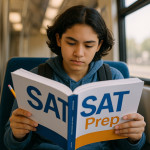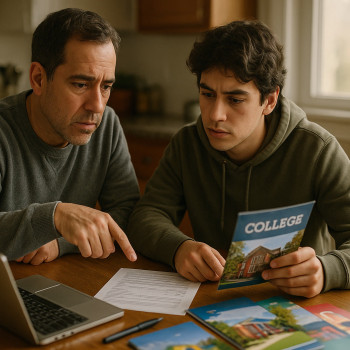Why budgeting for exams matters more than you think
There’s a quiet crunch that happens in junior and senior families across the country: between class materials, exam registrations, subject tests, and the little extras that pile up — the truth is, college readiness isn’t free. The Digital SAT, AP exams, IB exams, and the ACT each come with registration fees, possible late fees, score-send charges, and prep costs. Left unchecked, these expenses can turn preparation into a real financial stressor.
This guide is for students and parents who want clear, humane, practical advice on how to plan for the full cost of testing — not just the registration price, but the whole ecosystem: prep materials, practice tests, targeted tutoring, retakes, and smart choices that save money while still giving students the best chance to show their strengths.

Start with the facts: what you’ll likely pay
Before we talk strategy, let’s set expectations. The exact numbers can shift year to year, but the main categories are consistent. When you budget, think in these buckets:
- Registration fees (for SAT, ACT, IB, AP)
- Prep materials (books, online platforms, official practice tests)
- Tutoring (group vs. 1-on-1; short-term vs. ongoing)
- Administrative extras (late fees, center fees, score reports)
- Opportunity costs (time off work for parents, missed school days)
Typical cost snapshot (example breakdown)
Below is a sample budget snapshot to help you visualize what a test season might look like. These are illustrative categories to help you plan, and you can adjust values based on actual published fees and the student’s plan.
| Expense | Low | Typical | High | Notes |
|---|---|---|---|---|
| Digital SAT registration | $0 (waiver) | $60–$68 | $110+ (international + extras) | Includes basic registration; extra for international test centers |
| ACT registration | $0 (waiver) | $60–$70 | $90+ (with writing/late fees) | Varies if you add writing or late fees |
| AP exam (per subject) | $0 (school subsidy/waiver) | $95–$115 | $150+ (depending on school) | Many schools subsidize; costs vary worldwide |
| IB exam (per subject) | $0 (school support) | $120–$150 | $200+ | School policies differ; ask the IB coordinator |
| Commercial prep materials | $0 (free practice) | $30–$200 | $400+ (full course) | Books, official practice, online subscriptions |
| Tutoring (per hour) | $25 (group) | $60–$120 | $200+ (expert 1-on-1) | Group classes reduce per-hour cost; 1-on-1 is pricier but efficient |
How to prioritize where to spend (and where to save)
Not every dollar matters equally. Smart spending is about investment: where will money yield the best improvement in score, confidence, and college options? Here’s a prioritized approach.
1. Essentials first: registration and official practice
Secure fee waivers if eligible — many students qualify and this is a no-brainer. Next, use official practice materials. Official practice tests mirror the real exam most closely and are often free or low-cost. The return on investment here is huge because realistic practice yields better test-day familiarity and reduces the need for multiple retakes.
2. Targeted tutoring beats random hours
If you hire outside help, focus on targeted, short-term tutoring for high-impact gains: one semester of 1-on-1 sessions to shore up SAT sections where the student consistently loses points. One-on-one can be more expensive per hour, but it’s more efficient — you can often achieve meaningful score gains in fewer hours compared with generalized group classes.
For families balancing a tight budget, consider a hybrid model: a short block of 1-on-1 sessions to build strategy, then lower-cost group classes or self-study. Personalized programs — for example, tutoring that includes a tailored study plan plus progress tracking — can reduce wasted time and cost in the long run.
3. Coordinate tests strategically
Think calendar, not chaos. If a student plans to take the SAT, ACT, APs, and IBs, cluster preparation so there’s overlap in study material and timing. Reading and writing skills transfer; math practice benefits multiple tests. Aligning the prep schedule reduces repetitive study expenses and minimizes burnout.
4. School resources are gold
Don’t ignore what’s available through the school: counseling, test prep clubs, teacher office hours, and district-subsidized test days can dramatically reduce out-of-pocket costs. Many schools offer PSAT/NMSQT or school-day SAT options at discounted rates and can administer AP/IB registration through school processes that lower fees.
Practical savings tactics families can use right now
Stretching a prep budget doesn’t mean sacrificing fairness or effectiveness. Here are concrete, real-world moves students and parents can make.
Use official, free resources first
- Complete official practice tests under timed conditions — they’re the best indicator of how you’ll perform on test day.
- Explore free diagnostic tools to identify weaknesses before spending on tutoring or courses.
Bundle study time for multiple tests
If a student is preparing for AP English, IB English, and the SAT Evidence-Based Reading & Writing section, design study blocks that build the shared skills: reading comprehension, vocabulary in context, and essay structure. This reduces duplicate study hours and can shrink tutoring needs.
Compare tutoring formats and negotiate
Private tutors, test prep companies, peer tutors, and teacher-led sessions all offer different value. Don’t be shy about negotiating packages, asking for trial sessions, or opting for shorter, intensive tutoring blocks focused on one or two weaknesses.
Plan for retakes rationally
Retakes can improve scores but add to costs. Budget for one retake in most plans and treat additional retakes as conditional: only if the student’s practice scores show realistic improvement potential.
When personalized tutoring is worth the extra cost
Every student is different. For some, self-study and group courses produce solid gains. For others, personalized tutoring is the most efficient path — especially when time is limited or the student needs targeted strategy (e.g., for the Digital SAT interface or time management). Consider personalized tutoring when:
- The student’s practice tests show uneven strengths (very strong in one section, weak in another)
- There’s limited time before college application deadlines
- Previous attempts didn’t translate to score improvements despite study time
Personalized tutoring that pairs a tailored study plan with progress tracking and adaptive practice often shortens the journey from baseline to target score. Services that combine 1-on-1 guidance with AI-driven insights can further optimize each hour of tutoring by telling tutors precisely which skills to target — saving money overall by avoiding inefficient instruction. Sparkl’s personalized tutoring, for instance, blends expert tutors with tailored study plans and data-driven insights to focus effort on the highest-impact areas, which can be particularly helpful for students juggling APs, IB, and ACT prep at the same time.
Creating a sample budget plan: a realistic, step-by-step example
Below is a hypothetical family plan that covers one student preparing for the Digital SAT while also taking two AP exams and final IB assessments. Replace numbers with local fees and personal choices, but use the structure as a template.
| Item | Planned Cost | Notes |
|---|---|---|
| Digital SAT registration | $68 | Include potential test center fees or late fees in contingency |
| Two AP exam registrations | $200 (2 x $100) | Some schools subsidize; confirm with AP coordinator |
| IB exam fees (2 subjects) | $300 (2 x $150) | Check with the IB coordinator for school-specific pricing |
| Official practice tests & materials | $0–$50 | Many official resources are free; optional paid practice book |
| Hybrid tutoring (6 weeks) | $720 (12 sessions x $60) | 2 sessions/week, focused 1-on-1 blocks + follow-up practice |
| Contingency/retake budget | $100 | Set aside for a retake or score-sending fees |
| Total | $1,388 |
That total may look big, but a few adjustments — using fee waivers, school subsidies, or a shorter tutoring block — can lower it substantially. If a family prefers, an initial investment in a high-quality, personalized tutoring program that uses diagnostic testing and a tailored plan can lower total hours needed and therefore reduce total cost over the long run.
Smart timing: how to sequence tests to save money
Sequencing matters. Thoughtful timing reduces the need to retake and keeps stress down. Here’s a timeline strategy many families find helpful:
- Junior year fall: Take a diagnostic SAT or ACT; begin targeted prep after reviewing results.
- Junior year spring: Take the PSAT/NMSQT and sit for AP exams in May — PSAT practice doubles as SAT prep.
- Summer before senior year: Intensive, short-term prep for your chosen college exam (SAT or ACT) if needed.
- Early senior year fall: Final planned SAT/ACT attempt before applications are due. This minimizes the chance you’ll need another paid retake after deadlines.
When IB and AP exams are in the same season, coordinate revision schedules so that coursework and exam prep reinforce one another, instead of competing for time and money.
Fee waivers and subsidies — don’t overlook them
Many qualifying students can access fee waivers for SAT and ACT registration, reduced-cost AP exams, or school-funded IB fees. Eligibility rules vary by program, but the payoff is enormous. Work closely with school counselors early to see what’s available and how to apply. Even if you’re not sure you qualify, it’s worth checking — the paperwork is rarely complicated and the savings can be substantial.
Real-world examples: families who cut costs without cutting quality
Here are two short, anonymized stories to illustrate practical choices:
Case 1: Emma — targeted 1-on-1 for fast gains
Emma was balancing AP Bio and IB English. Her PSAT suggested she could get a much higher SAT math score with focused strategy. Instead of buying a full commercial course, her parents invested in 8 1-on-1 sessions centered on SAT math strategy and pacing. She practiced with official digital practice sets between sessions. Result: a 70-point gain on math and no need for a second test attempt. The upfront cost was lower than a multi-month course and saved money by avoiding a retake.
Case 2: Marcus — school resources first, supplement smartly
Marcus’s school offered SAT School Day at a reduced price and an after-school SAT club. He used the club for weekly practice and purchased one official practice book. For the final month, he enrolled in a short, affordable group workshop focused on test strategies. These combined low-cost options saved his family over $800 compared to a private course, while giving him the structure and practice he needed.
Checklist: monthly prep budget planner
Use this checklist to make sure you’re covering the essentials in any given month during a test season.
- Week 1: Take a timed official practice test to benchmark.
- Week 2: Review results; identify top 3 weaknesses.
- Week 3: Book targeted sessions (group or 1-on-1) focused on those weaknesses.
- Week 4: Simulate test conditions; log progress and adjust plan.
- End of month: Review budget — did tutoring hours match expected progress?
How to decide between DIY, group classes, and 1-on-1 tutoring
Here’s a quick decision guide to help you choose the right mix:
- If the student is disciplined, has steady practice scores, and needs gradual improvement: lean DIY + free official materials.
- If the student benefits from community, deadlines, and structured lessons: group classes are efficient and cheaper per hour.
- If the student needs specific skill repair, test strategy, or time is limited: invest in short-term 1-on-1 tutoring. It often produces the fastest, most predictable improvement.
Remember: the goal is not to spend the most money, but to spend strategically so the student spends less time and stress getting to their target score.
Final thoughts: invest where it counts, save where it doesn’t
Budgeting SAT prep alongside AP, IB, and ACT expenses is about clarity and priorities. Start by understanding registration fees and school supports. Use official practice materials early and often. Reserve paid tutoring for targeted, high-impact gaps. Coordinate test timing so one study plan supports multiple exams. And always weigh cost against time saved — sometimes the higher hourly rate of 1-on-1 tutoring results in fewer total hours and a lower overall bill.
For families considering an investment in personalized support, programs that combine expert tutors with tailored study plans and adaptive insights can be especially cost-effective, because they streamline progress and reduce wasted hours. Sparkl’s personalized tutoring, which offers 1-on-1 guidance, customized study plans, and data-driven recommendations, is an example of how focused support can be used strategically alongside school resources and official practice materials.
Parting checklist: what to do this month
- Confirm exact registration fees and deadlines for your test dates.
- Ask your school counselor about fee waivers and school-day testing options.
- Take one official, timed practice test to create a baseline.
- Decide whether you need short-term 1-on-1 tutoring or a lower-cost group option.
- Set aside a small retake fund — it reduces stress and prevents last-minute cash surprises.

Where to go from here
Budgeting tests and prep doesn’t have to be overwhelming. With a clear plan, a prioritized budget, and smart use of both free and paid resources, you can give the student a strong shot at their goal without financial burnout. Start small, measure progress often, and be deliberate about where each dollar — and hour — goes. That combination of prudence and strategy is what wins the day.
If you’d like, I can help you build a personalized budget based on your student’s current scores, intended test schedule, and how many AP/IB exams they’re planning. We can map exact test dates, realistic tutoring hours, and a contingency fund so you go into the season calm, prepared, and in control.


















No Comments
Leave a comment Cancel